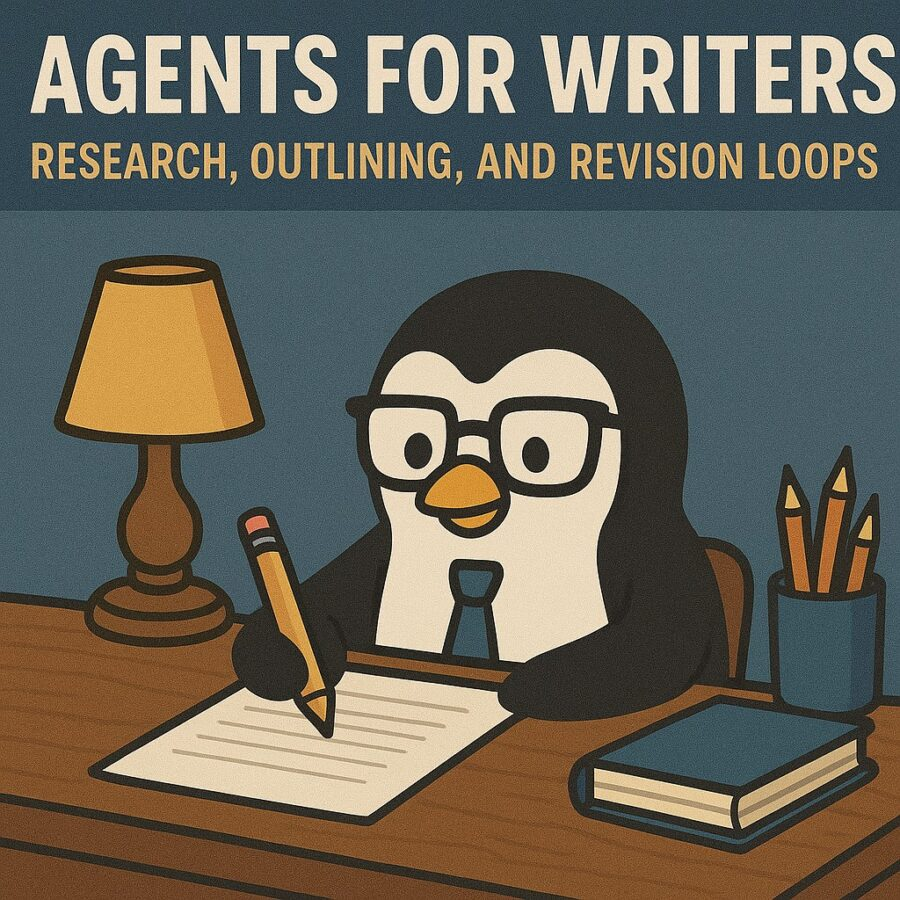Views: 0
Writers have a secret today. The strongest draft rarely starts on a blank page. It starts with agents. Agents For Writers: Research, Outlining, And Revision Loops is a practical system for turning AI agents into a dependable writing crew. You get quiet speed during research. You get crisp structure during outlining. You get clean copy during revision. The goal is not to outsource your voice. The goal is to build reliable helpers that shorten the slog and raise the floor on quality.
You will set up three small agents. A Researcher that verifies facts and collects sources. An Outliner that turns messy notes into a clear plan. A Reviser that trims, scores readability, and checks citations. Each agent is specialized. Each one hands off work to the next. The handoff is the magic. It creates a closed loop you can trust on deadline.
Modern models make this easier. OpenAI’s reasoning models, like o3 and o4-mini, were built to spend more time thinking through complex tasks. That helps when an agent must plan steps or choose tools. These models route between quick responses and deeper analysis to fit the job. (OpenAI) Newer releases also raised the bar on general writing and analysis, which matters when you ask for synthesis across many sources. (OpenAI) You can also lean on multi-agent frameworks like CrewAI or LlamaIndex when you want more control over roles, tools, and document workflows. (CrewAI Documentation) Some platforms integrate reasoning into research flows directly, so an agent can gather, compare, and draft in one pass. You still verify outputs, but the time savings are real. (The Guardian)
This article shows how to design the three agents, how to connect them, and how to run tight loops that respect facts. We will also align the workflow with proven source evaluation and readability checks. The result is a repeatable pipeline you can run for articles, reports, newsletters, or scripts.
Why agents, and why now
Two forces changed the craft. First, agent frameworks matured. You can define roles, equip tools, and orchestrate handoffs with less code. CrewAI treats each agent like a team member with a job and a toolbelt, while LlamaIndex adds document-aware workflows that combine retrieval, structured outputs, and orchestration. (CrewAI Documentation) Second, reasoning models improved planning and analysis. That helps an agent split a task into steps, cite sources, and choose when to think slower for accuracy. (OpenAI)
This is not theory. Tutorials from LangChain and LlamaIndex walk through agents that call search tools, evaluate results, and return structured notes. (LangChain) Even if you never write code, these designs guide how you write prompts inside ChatGPT or any studio that exposes agent features.
The three-agent pipeline at a glance
You will build a small crew.
- The Researcher gathers sources, checks credibility, and extracts key facts with citations.
- The Outliner clusters those facts into a structure that fits your audience.
- The Reviser polishes the draft with style checks, readability scores, and source audits.
Each agent has a single outcome. Each one documents its process. You connect them in a loop. If the Reviser flags a weak claim, the thread routes back to the Researcher with a targeted request for stronger support. If the Outliner discovers a missing section, it calls the Researcher to fill the gap. You publish only when the loop runs clean.
Affiliate Link
See our Affiliate Disclosure page for more details on what affiliate links do for our website.

Build the Researcher
The Researcher does four jobs. Discover. Filter. Extract. Attribute. Equip it with clear rules for source quality, because speed without rigor harms trust.
Use two simple evaluation frameworks to keep your facts clean. The SIFT method helps you slow down and check a source fast. Stop. Investigate the source. Find better coverage. Trace the claim to the original context. (Pressbooks) The CRAAP test adds a structured scan for Currency, Relevance, Authority, Accuracy, and Purpose. Ask those five questions for each key claim before it enters your notes. (Research Guides)
Your Researcher should also record the exact URLs, titles, and dates for every citation. Store a one-sentence summary of what each source adds. Tag uncertain items for follow-up. A strong Researcher refuses vague facts and unlabeled charts.
Here is a clean prompt to run inside your agent or model of choice. Adapt as needed.
Prompt: “Act as my Researcher. For the topic [TOPIC], find 8 to 12 credible sources. Apply SIFT, then the CRAAP test, and reject low-quality items. Return a table with: title, author, publication, date, URL, summary of the claim, and why it is credible. Extract 12 key facts with short quotes and page citations. Flag any claims that need primary confirmation.”
You can enhance this with a framework. CrewAI can give your Researcher a role, goals, and tools like web search, PDF reading, or spreadsheet export. (CrewAI Documentation) LlamaIndex can attach the Researcher to an Agentic Document Workflow, so it chunks sources, retrieves context, and outputs structured notes with citations. (LlamaIndex) If you prefer a lighter setup, LangChain’s agent tutorials show how to call a search tool and reason about results step by step. (LangChain)
Reasoning models help here. o3 and o4-mini can spend more cycles to decompose steps and avoid shallow answers. That is useful when the Researcher compares conflicting sources or must summarize a long PDF accurately. (OpenAI)
Build the Outliner
The Outliner converts raw research into structure. It must reflect your audience, your purpose, and your platform. For an article, you want a clear hierarchy with a promise up top, evidence in the middle, and a payoff at the end. For a video, you want a cold open, stakes, and reveals.
Give the Outliner a small set of rules. One idea per section. Clear hierarchy. Logical order. Smooth transitions. Use descriptive subheads that carry meaning when skimmed. The Outliner should also surface what is missing. If the draft leans on a statistic, the Outliner asks for a primary source. If the argument lacks a counterpoint, it requests one.
Here is a strong prompt to shape structure.
Prompt: “Act as my Outliner. Using the research notes and citations provided, build a detailed outline for [AUDIENCE] on [TOPIC]. Start with a hook that names the outcome. Group related facts into sections with H2 and H3 labels. For each section, supply a purpose sentence, a list of claims with citations, and a suggested visual or example. Flag gaps that require more research.”
Frameworks help with documents that live in many files. LlamaIndex’s agentic document workflows are designed for end-to-end knowledge work. They connect retrieval, structured outputs, and orchestration into a single path, which suits a research-to-outline flow. (LlamaIndex) If your project involves multiple roles, CrewAI can run an Outliner that reads the Researcher’s spreadsheet, then passes a structured outline to the Reviser. (CrewAI Documentation)
Affiliate Link
See our Affiliate Disclosure page for more details on what affiliate links do for our website.
Build the Reviser
The Reviser cleans, scores, and guards against drift. It trims filler, simplifies sentences, and raises clarity. It checks facts against listed sources. It scores readability. It confirms that quotes match the originals. It looks for claims that lack citations. It checks for hedging that hides uncertainty.
Use objective readability checks to keep your voice accessible. The Flesch Reading Ease and Flesch-Kincaid grade formulas are standard ways to estimate difficulty. High scores indicate easier reading, and grade scores map to U.S. grade levels. These tests use sentence length and syllable counts to produce a number you can track over time. (Wikipedia)
Automated feedback tools can assist here. Studies report that AI-assisted feedback improves revision practices for some learners, and even adoption patterns have been measured in academic settings. These findings should not replace human judgment, but they show value in a loop where a model gives targeted edits and a writer accepts or rejects them with intent. (SpringerLink) Some tools also produce authorship and activity reports, which can help teams acknowledge AI assistance in formal settings. (Artificial intelligence)
Give your Reviser this practical brief.
Prompt: “Act as my Reviser. Improve clarity and flow without changing my voice. Keep sentences tight. Replace jargon with plain terms. Highlight claims and pair them with citations from the research table. Insert missing citations as TODO items. Score the draft with Flesch Reading Ease and Flesch-Kincaid grade. Suggest two shorter alternative sentences for any line over 22 words. List factual risks to verify.”
Orchestrate the loop
Now connect the crew. The flow is simple. Researcher produces a source table and fact list. Outliner converts those into sections with purpose lines and evidence. Reviser cleans the prose, checks readability, and inspects citations. Any issue routes back.
A small checklist keeps the loop honest.
- Every claim is tied to a named source and date.
- Every section has a purpose line that a skimmer can understand.
- Every paragraph contains a concrete fact, example, or step.
- Readability stays within your target band.
- The final draft states what remains uncertain.
Reasoning models help coordinate decisions here too. They can slow down on hard calls, like reconciling conflicting studies or proposing a fair counterargument. They can also speed up on routine edits. That balance keeps the loop fast without losing rigor. (OpenAI)
A working day with Agents For Writers: Research, Outlining, And Revision Loops
Start with a topic phrased as a reader outcome. Ask the Researcher for 10 sources with SIFT and CRAAP checks. It returns a table with summaries and reliability notes. Skim those notes and remove any borderline items. Ask the Researcher to fill gaps for disputed facts or missing dates.
Pass the research to the Outliner. It writes a hierarchy that walks a busy reader through the promise, the proof, and the payoff. It lists the claims and cites sources inside the outline. It also proposes visuals, like a timeline, table, or chart. If it flags a missing counterpoint, send a query back to the Researcher with a precise ask.
Draft from the outline. Keep your paragraphs short and specific. Avoid throat-clearing lines. Let facts lead.
Run the draft through the Reviser. It trims filler, checks style, and scores readability. It confirms that citations match sources. If a claim is shaky, the loop routes back. Two cycles are common. Three cycles for complex topics.
End with a final scan. Confirm that each section earns its place. Confirm that your conclusion restates value. Confirm that your uncertainty notes are honest. Publish.
Platform notes for writers who publish across formats
Your agents can adapt to your platform stack. Use different output formats with the same core loop.
Long-form articles. Ask the Outliner to produce H2 and H3 structure with purpose lines and citation notes. Ask the Reviser to aim for a specific grade level and to flag any line that exceeds your target word count. Keep your opening section focused on outcome first.
Newsletters. Ask the Outliner for a hybrid structure. Lead with a promise. Add a “What this means” paragraph. Follow with a “How to use it” section. Ask the Reviser to tighten the subject line to 45 characters and echo the opener in the preview text.
YouTube or podcasts. Ask the Outliner for a cold open that states the payoff inside 8 seconds. Ask for two cutaway points to show proof at 30 and 90 seconds. Your Reviser should trim spoken lines for breath and cadence. This is where shorter sentences pay off.
Threads and posts. Ask the Outliner for a one-sentence hook and three proof points with citations. Ask the Reviser to remove filler and keep each line scannable. You can then expand any proof into a follow-up post with the same research base.
Affiliate Link
See our Affiliate Disclosure page for more details on what affiliate links do for our website.
Choosing tools and frameworks
If you are comfortable with no-code or low-code, start inside a studio that exposes agent features and research tools. Some platforms now ship a deep research mode that can pursue many sources in parallel, then present a report. Always verify the citations and re-state claims in your own words. (The Guardian)
If you prefer open frameworks, CrewAI is a good choice for multi-agent orchestration with role definitions and a visual builder. It integrates with tools like Notion, Slack, or CRMs, which helps when your research and editing happen across systems. (CrewAI) LlamaIndex is strong when your work revolves around documents. Its agentic document workflows connect retrieval, structured outputs, and orchestration into one path. That suits research, outlining, and revision loops that must stay aligned to source files. (LlamaIndex) LangChain remains a popular way to teach an agent how to use a search tool, call functions, and reason about intermediate steps. Its tutorials are a clear starting point. (LangChain)
On the model side, reasoning models like o3 and o4-mini shine when you need planning or careful comparison. They trade speed for thinking when required. Azure documents discuss when to choose reasoning models over general chat models, which helps when you want predictable depth during research or outlining. (Microsoft Learn) Newer releases show stronger writing and analysis as well, which you notice when the Outliner synthesizes many sources or the Reviser weighs competing claims. (OpenAI)
Guardrails for accuracy and ethics
Agents amplify your choices. Use them to raise standards, not lower them.
Always disclose assistance in formal contexts. If your organization requires it, keep an authorship log. Some tools can show activity, editing sessions, and sources of text. That helps teams acknowledge AI use and maintain trust. (Artificial intelligence)
Prefer primary sources. Summaries are helpful, but your Researcher should trace claims to the original paper, dataset, or press release before the claim enters your draft. That is the “T” in SIFT. (Pressbooks)
Measure readability. Pick a target band that fits your audience. Flesch Reading Ease and Flesch-Kincaid Grade are simple, consistent scores you can track for every piece. They are not perfect. They are useful. (Wikipedia)
Beware tool limits. Some revision tools cap analysis length or work best under certain sizes. Break big projects into logical chunks and reassemble them after checks. (Ground Crew Editorial)
Use reasoned models for planning. When a step matters, trade speed for depth. o3 and its peers were built for this. They can plan, check, and compare with fewer shallow errors than prior chat-only models. (OpenAI)
A 90-minute sprint you can repeat each week
Set a timer. Run this once for a new piece.
Minutes 0 to 30. Researcher collects 10 sources. It applies SIFT and CRAAP. It extracts 12 facts with short quotes and page numbers. You remove two weak sources and ask for two replacements. (Pressbooks)
Minutes 30 to 60. Outliner proposes a hierarchy. It writes purpose lines and places citations at the claim level. It recommends one chart and one table. You accept the structure and add a personal story for context.
Minutes 60 to 90. You draft from the outline. Reviser trims and scores. It flags three long sentences and a claim without a date. The loop returns to the Researcher for the missing date. You paste the fix. The piece clears your readability target. (Wikipedia)
Do this cycle often. Your crew will feel natural in a week. Your output will feel calmer and more consistent.
Affiliate Link
See our Affiliate Disclosure page for more details on what affiliate links do for our website.
Troubleshooting the loop
Problem. Sources disagree.
Fix. Ask the Researcher to trace both claims to the earliest primary source. Then ask for a neutral summary of differences, including sample size and method. Mark the uncertainty in your draft.
Problem. Outline feels thin.
Fix. Ask the Outliner to propose three alternative structures that tell the same story from different angles. Outcome first. Objection first. Chronology first. Pick the one that fits your readers.
Problem. Draft reads dense.
Fix. Ask the Reviser to segment long sentences into two options each, then score both versions. Replace nominalizations with verbs. Confirm that each paragraph contains one idea and one concrete example. Track the new readability score. (Readable)
Problem. Research drifts to low-quality blogs.
Fix. Tighten the Researcher’s instructions. Prefer peer-reviewed journals, government sites, university guides, documentation, and major publications. Apply SIFT and CRAAP before extraction. (Pressbooks)
Problem. Agent stalls on a complex step.
Fix. Switch to a reasoning model for that one step. Ask it to think through options and produce a plan with tradeoffs. Then continue the loop. (OpenAI)
Templates you can paste into your agents
These three prompts keep your crew aligned to Agents For Writers: Research, Outlining, And Revision Loops. Use them as defaults.
Prompt: “You are the Researcher. Topic: [TOPIC]. Deliver a table of 10 sources with title, author, date, URL, SIFT and CRAAP notes, and a one-sentence claim. Extract 12 facts with short quotes, page numbers, and context. Prefer primary sources. Flag conflicts.”
Prompt: “You are the Outliner. Audience: [AUDIENCE]. Goal: [OUTCOME]. Using the research table and fact list, create H2 and H3 headings with purpose lines. Attach citations to claims. Propose one visual per section. List three missing counterpoints or risks that need research.”
Prompt: “You are the Reviser. Improve clarity without changing voice. Keep sentences short. Replace jargon. Score Flesch Reading Ease and Flesch-Kincaid grade. Mark any claim without a source. Suggest two shorter alternatives for lines over 22 words. List three factual risks and route them to Researcher.”
Where this is heading
Agent design is moving fast. Frameworks now support teams of agents with clear roles and shared memory. (GitHub) Document-aware systems chain retrieval, reasoning, and structure into one smooth path. (LlamaIndex) Reasoning models pull double duty, switching between fast and deep as needed. (Microsoft Learn) Even general studios ship deep research modes that can scan many sources and draft a report you can then edit with your own judgment. (The Guardian)
For writers, the promise is not a robot author. It is a quiet crew that does the heavy lifting around you. You still decide what matters. You still choose the angle. You still carry the style. Agents For Writers: Research, Outlining, And Revision Loops gives you a way to protect that craft while multiplying your output.
Use the system on your next piece. Start with a crisp topic and outcome. Run the Researcher with SIFT and CRAAP. Shape a strong outline that puts value first. Revise with real scores and honest citations. Close the loop with one rule. When facts wobble, route back. Publish with confidence that your crew did the work and you kept the standard high.





